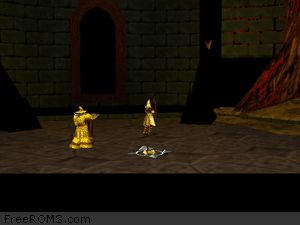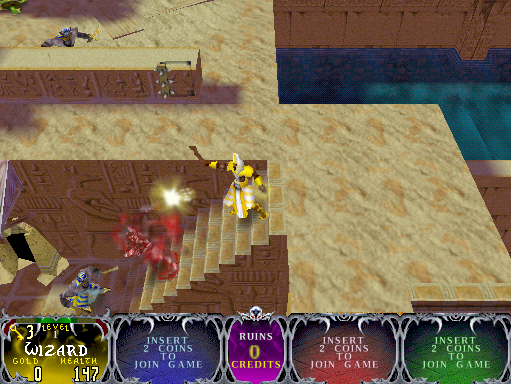
- #Gauntlet legends n64 rom problem update
- #Gauntlet legends n64 rom problem code
- #Gauntlet legends n64 rom problem download
I suspect that the game loads data somewhere just once in RDRAM that deals with the HUD, before entering a different area/stage. There's a minor performance hit, compared to the old bypass method that had flickering, but nothing major.Īnyway, I started looking into the HUD issue. So i'm kinda waiting for that to happen because I really don't like this workaround.ĭoes it fix the high CPU utilization during HLE mode? It would be much better to just add a variable to the spec for signalling a yield in HLE. I had to use a very ugly workaround where I used an unused RDP register for signaling. I think the main issue really is the plugin spec.

#Gauntlet legends n64 rom problem code
Does M64p compile with msvc? I might need to debug their code to see why the performance is not good. I don't have the source with me right now though. Upon resuming the yielded task, I made the code immediately jump back to the same branch function and check if it's still an infinite loop. When the inf loop happens, signal that it exited early and exit the DList immediately. Gauntlet's method seems less efficient, but my guess is that they didn't want to tweak the microcode for that.Īll I did was use a global variable that both the RSP and GFX plugin can access, that signals whether yielding happened in HLE. It differs from WDC, Stunt Racer, Pokemon Stadium 2 GB Tower, in that Gauntlet makes the branching command infinite loop for the RSP to wait for CPU if it's too far ahead, instead of using the RSP yield signal. I assume that the CPU changes some of the DList data. From my debugging session, I found that the flickering could not be avoided without letting the cpu run for a while.

Was it indeed a yielding issue, a ucode issue, or what I do believe, a combination of both? I don't know if the zilmar specs provide a sufficient ground to do this also. Not sure that even LLE plugin does all of this by the way. This initialization should include restoring registers (from the saved DMEM) and possibly overlaying code segments. The microcode will detect the OS_TASK_YIELDED bit in the task header flags and perform the proper initialization, before resuming execution. Restarting a previously yielded task is conceptually simple the previously-saved DMEM data (from the yield buffer) is used as the ucode_data field in the task header, and the OS_TASK_YIELDED bit in the It might also modify internal state, so that the yielded task can be restarted. The microcode also sets the SP_YIELDED bit in the Coprocessor 0 Status Register.Īfter requesting a yield, the host CPU must wait for the RSP task to finish and verify that it actually yielded. Supplied to the task as part of the task header). The microcode saves a handful of important registers to DMEM, then DMA’s the necessary portion of DMEM to the yield buffer (originally The microcode’s responsibility during yield is, by design, minimal. The test is relatively cheap, only a few cycles, and this guarantees that we will test every several hundred clock cycles at the most. It would be inefficient to check too often, but it would also be dangerous to not check often enough, possibly detecting the yield too late.įor the released graphics microcode, we check for the yield after processing every display list command. The microcode checks periodically for a yield request.

This function sets the Coprocessor 0 Status Register bit SP_SET_YIELD.
#Gauntlet legends n64 rom problem download
To download a core, open Retroarch, and from the leftmost icon (Main Menu), go to “Load Core,” then “Download Core.A bit of documentation, even if someone would like to tackle the matter:Īn application requests an RSP task to yield by calling osSpTaskYield(). Cores are essentially emulators designed to work specifically in Retroarch and are usually based on existing emulators. Once you’ve installed the latest version of Retroarch, you’ll need to choose from one of the two main N64 cores. IN Retroarch, just go to Settings -> User Interface -> Menu and change it to ‘ozone’ What Is the Best N64 Core in Retroarch
#Gauntlet legends n64 rom problem update
To make things simpler, you can update the XMB UI to look like the new UI we use here. If you’re still on the old XMB UI, then the guide still completely applies – it’s just that it will look different on your screen. Note: We’ve updated this guide to reflect the new Ozone UI that Retroarch has been using for a while now.
-8.jpg)
Here, we’ll show you the best way to get Retroarch to run your N64 collection. The emulation frontend Retroarch is arguably the best N64 emulator out there, letting you run several different N64 emulators as “cores” (as well as letting you play PS1, SNES, Sega Genesis, and various other retro console games on your PC).


 0 kommentar(er)
0 kommentar(er)
